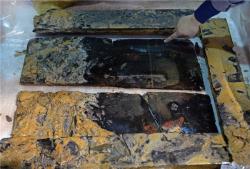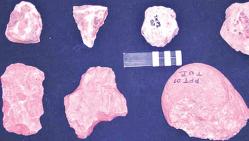INSTITUT SUPERIEUR D'ANTHROPOLOGIE
INSTITUTE OF ANTHROPOLOGY
ONLINE COURSES / COURS A DISTANCE
WINTER TERM : JANUARY 2016
REGISTER NOW
CHINE –  Nanchang - Chinese archaeologists claimed on Saturday to have unearthed a portrait of Confucius from a tomb that is at least 2,000 years old. After they pieced together a broken lacquer screen found in the main chamber of the tomb, the archaeologists said, they restored two portraits, one of which is believed to be of Confucius. "The Chinese characters on the screen include the names of Confucius, his father, Shu Lianghe, and one of his favourite disciples, Yan Hui," said Zhang Zhongli, deputy chief of the excavation team in east China's Jiangxi province. "These names are evidence that at least one of the two men painted on the screen is Confucius himself." He said the text on the screen was probably a brief biography of Confucius, but further evidence is needed to support the hypothesis. Screens were typical furniture in ancient Chinese homes to block wind and evil spirits and to protect privacy. They were often painted with landscapes, plants or calligraphy. The restored screen is 50 to 60 centimeters wide and 70 to 80 centimeters tall. Both portraits are blurred, but details of the subjects' collars and robes are clearly seen, said Zhang. "We assume the tomb owner respected Confucius and had a Confucius portrait painted on the screen," said Zhang. "After he died, his family buried his favourite screen with him, even though such screens were not conventional burial items in Chinese funerary customs." Zhang, an archaeologist from Shaanxi Provincial Institute of Archaeology, is leading the excavation of the tomb of Haihunhou, or the Marquis of Haihun, which dates back to the Western Han Dynasty (206 BC-AD 24). The tomb owner is believed to be Liu He, grandson of Emperor Wu, whose reign ushered in one of the most prosperous periods in China's history. The finding of the Confucius portrait in the marquis' tomb indicates Confucius' teachings were prevalent among the ruling class in the Western Han Dynasty, Zhang said. "This is the earliest portrait of the ancient sage discovered so far," said Xin Lixiang, head of the excavation team and one of China's most authoritative archaeologists for the Qin and Han dynasties.
Nanchang - Chinese archaeologists claimed on Saturday to have unearthed a portrait of Confucius from a tomb that is at least 2,000 years old. After they pieced together a broken lacquer screen found in the main chamber of the tomb, the archaeologists said, they restored two portraits, one of which is believed to be of Confucius. "The Chinese characters on the screen include the names of Confucius, his father, Shu Lianghe, and one of his favourite disciples, Yan Hui," said Zhang Zhongli, deputy chief of the excavation team in east China's Jiangxi province. "These names are evidence that at least one of the two men painted on the screen is Confucius himself." He said the text on the screen was probably a brief biography of Confucius, but further evidence is needed to support the hypothesis. Screens were typical furniture in ancient Chinese homes to block wind and evil spirits and to protect privacy. They were often painted with landscapes, plants or calligraphy. The restored screen is 50 to 60 centimeters wide and 70 to 80 centimeters tall. Both portraits are blurred, but details of the subjects' collars and robes are clearly seen, said Zhang. "We assume the tomb owner respected Confucius and had a Confucius portrait painted on the screen," said Zhang. "After he died, his family buried his favourite screen with him, even though such screens were not conventional burial items in Chinese funerary customs." Zhang, an archaeologist from Shaanxi Provincial Institute of Archaeology, is leading the excavation of the tomb of Haihunhou, or the Marquis of Haihun, which dates back to the Western Han Dynasty (206 BC-AD 24). The tomb owner is believed to be Liu He, grandson of Emperor Wu, whose reign ushered in one of the most prosperous periods in China's history. The finding of the Confucius portrait in the marquis' tomb indicates Confucius' teachings were prevalent among the ruling class in the Western Han Dynasty, Zhang said. "This is the earliest portrait of the ancient sage discovered so far," said Xin Lixiang, head of the excavation team and one of China's most authoritative archaeologists for the Qin and Han dynasties.
http://news.asiaone.com/news/asia/portraits-found-tomb-may-include-image-confucius
NOUVELLE ZELANDE - South Taranaki - A pa sacked by General Trevor Chute during the land wars in the 1860s may have been rediscovered under roadworks in South Taranaki.' A pa is a fortified village, and Ketemarae was a four palisade pa at the centre of a wealthy village. It was overrun in 1886 by 600 men General Chute had assembled to clear rebellious Maori from Taranaki - the last campaign by imperial troops in the country. The New Zealand Transport Agency had been keeping the hapu up to date with developments during the project, Mr Tongaawhikau said. "They've found remnants of old papakaianga (housing) along the way and old things just up and down the place you know, old houses and things. And how old they are I don't know but they have to let us know. "And when I see some of our old sketchings of what was there it doesn't surprise me that they have found palisades there to be honest." Ketemarae was still dear to the hearts of his people. "One of the whare tipuna (ancestral houses) that's sitting on our marae which is just up the road, that comes from Ketemarae and in actual fact a lot of our old people still call our marae, Ngarongo, Ketemarae because of the mana of that particular whare tipuna."nIf the archaeological find involved something significant Mr Tongaawhikau said he would want roadworks halted.
http://www.radionz.co.nz/news/regional/289655/roadworks-unearth-possible-pa-site
INDE –  Pillayarpatti - Recent archaeological excavation undertaken at the Tamil University campus in Pillayarpatti has pushed back the history of human settlements in the area to around 8,000 BC, that is around 10,000 years from now. A team of archaeologists and students of the Department of Epigraphy And Archaeology, Tamil University carried out excavation work in the University campus at Pillayarpatti from June 2015, with the permission from the Archaeological Survey of India (ASI) and completed the work recently. The site, measuring 5X5 square metre dug up to one metre, yielded valuable evidences to study the history of human settlements in the area. The laterite soil in the area contained quartz and chert stones. Artefacts made from these stones were also found. “During the excavation, we found pointed tools such as arrows and scrappers used for scrapping fat from animals or the bark of trees, flakes, borers made of stones” V Selvakumar, Assistant Professor told Express. He pointed out that fossils of trees, probably of banana, were also found in the area. Further, he claimed that since Pillayarpatti is at a higher altitude compared to Cauvery delta, the people in the delta plains might have seasonally migrated to Pillayarpatti during floods. Similar migration might have occurred to nearby areas like Manojippatti, Tirukkanoorpatti and Punalkulam, Selvakumar pointed out the existence of an ancient stream near the excavation site and also an ancient rain water harvesting well nearby. “It is significant iron age tools, microlithic tools and tools from the end of paleolithic age were found in subsequent layers, ”he added.
Pillayarpatti - Recent archaeological excavation undertaken at the Tamil University campus in Pillayarpatti has pushed back the history of human settlements in the area to around 8,000 BC, that is around 10,000 years from now. A team of archaeologists and students of the Department of Epigraphy And Archaeology, Tamil University carried out excavation work in the University campus at Pillayarpatti from June 2015, with the permission from the Archaeological Survey of India (ASI) and completed the work recently. The site, measuring 5X5 square metre dug up to one metre, yielded valuable evidences to study the history of human settlements in the area. The laterite soil in the area contained quartz and chert stones. Artefacts made from these stones were also found. “During the excavation, we found pointed tools such as arrows and scrappers used for scrapping fat from animals or the bark of trees, flakes, borers made of stones” V Selvakumar, Assistant Professor told Express. He pointed out that fossils of trees, probably of banana, were also found in the area. Further, he claimed that since Pillayarpatti is at a higher altitude compared to Cauvery delta, the people in the delta plains might have seasonally migrated to Pillayarpatti during floods. Similar migration might have occurred to nearby areas like Manojippatti, Tirukkanoorpatti and Punalkulam, Selvakumar pointed out the existence of an ancient stream near the excavation site and also an ancient rain water harvesting well nearby. “It is significant iron age tools, microlithic tools and tools from the end of paleolithic age were found in subsequent layers, ”he added.
http://www.newindianexpress.com/states/tamil_nadu/New-Proof-Pushes-Back-Date-of-Human-Settlements-in-Thanjai/2015/11/16/article3130537.ece